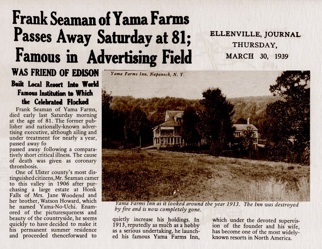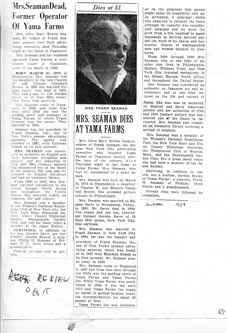Yama Farms Inn: A Home in the Mountains


Declining Years

In 1934, just a few years before his death, Frank Seaman married his long time companion, Olive Brown Sarre.
In existence from 1903 to 1938, Yama-no-uchi and Yama Farms Inn lasted a mere 35 years. As a private estate and architectural marvel, however, and as an inn, Yama Farms spanned several distinct eras in American history. All left their successive imprints upon Frank Seaman, Olive Sarre, the Yama Farms Inn guests and staff, as well as upon daily life at the Inn itself.
The Gilded Age is remembered as a time when the wealthy paid no income tax, industries were entirely unregulated, and the great mass of American citizens had no social safety net to protect them. Although the Gilded Age came to a close at least a decade before Seaman purchased the property, Gilded Age values and the fortunes generated by its economy sustained Yama Farms during its early years. Shaping Yama Farms and bringing it national attention were many of the ideals and ideology of the Progressive Era. The guest list reveals that the Inn was exposed to the cosmopolitanism, artistic energy, and waves of internationalism that followed World War I. Its most loyal guests, however, were members of the generation born during the Civil War years. These men and women were thus somewhat at a remove from the cultural effects of World War I and its aftermath. By the time of the Jazz Age and “flaming youth,” the cohort that formed the core of its guest list was already part of an aging and disapproving “establishment.” In the course of the Great Depression—those years that lay between the 1929 stock market crash and America’s entry into World War II—the culture and economy that created the world of Yama Farms gradually vanished.


Frank Seaman died in 1939 at the age of 81. A few years later Olive Brown Sarre sold the Inn but continued to own and live in the Hut. She died in 1954, also at the age of 81.
Frank Seaman dissolved his ad agency in 1927. Following the death of his first wife, Lily Huntington (from whom he was separated) in 1934, Seaman married his longtime companion Olive Sarre. Shortly afterwards, his health and the Inn went into a decline. Many of its guests were now elderly and many had lost their money in the stock market crash. In addition, the buildings and grounds were no longer well maintained. When Seamen died in 1939 at the age of 81, his ashes were sprinkled behind the Hut. He left the Yama Farms property to Sarre and to his son Julian. Sarre stayed on at the Hut, joined by her brother and his family. She seems to have had strong friendships and was active in many organizations. In 1944 she sold the Inn to the first of a series of investors who would attempt to run it as a typical mid 20th-century Catskills resort.
When Olive Sarre passed away at the age of 81 in 1954, much of the Hut’s contents were auctioned off. Fortunately, the Ellenville Public Library and Museum purchased some of this material. It is now accessible to researchers and can be viewed by the public. Recently, Olive Sarre’s great-grandniece, the late Jyoti Chrystal and Frank Seaman’s great-grandson, Kenneth Chase, shared family stories, artifacts, photographs, letters, and memoirs—many of which have been incorporated into this website. We are grateful for their generosity.
